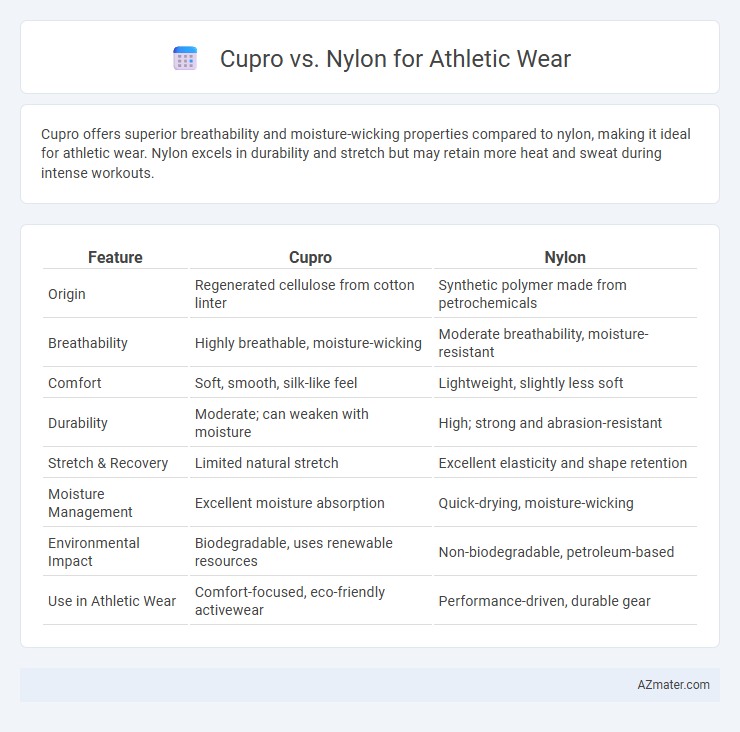Cupro offers superior breathability and moisture-wicking properties compared to nylon, making it ideal for athletic wear. Nylon excels in durability and stretch but may retain more heat and sweat during intense workouts.
Table of Comparison
| Feature | Cupro | Nylon |
|---|---|---|
| Origin | Regenerated cellulose from cotton linter | Synthetic polymer made from petrochemicals |
| Breathability | Highly breathable, moisture-wicking | Moderate breathability, moisture-resistant |
| Comfort | Soft, smooth, silk-like feel | Lightweight, slightly less soft |
| Durability | Moderate; can weaken with moisture | High; strong and abrasion-resistant |
| Stretch & Recovery | Limited natural stretch | Excellent elasticity and shape retention |
| Moisture Management | Excellent moisture absorption | Quick-drying, moisture-wicking |
| Environmental Impact | Biodegradable, uses renewable resources | Non-biodegradable, petroleum-based |
| Use in Athletic Wear | Comfort-focused, eco-friendly activewear | Performance-driven, durable gear |
Introduction to Cupro and Nylon in Athletic Wear
Cupro, a regenerated cellulose fiber derived from cotton linter, offers a breathable, moisture-wicking, and biodegradable option for athletic wear, promoting comfort and sustainability. Nylon, a synthetic polymer known for its exceptional durability, elasticity, and quick-drying properties, remains a staple in performance apparel for high-intensity activities. Both materials cater to different athletic needs, balancing comfort, environmental impact, and functionality in sportswear design.
Material Origins: How Cupro and Nylon Are Made
Cupro, a regenerated cellulose fiber derived from cotton linter, undergoes a chemical process that dissolves the cotton byproducts and re-spins them into a smooth, breathable fabric ideal for athletic wear. Nylon is a synthetic polymer created through a chemical reaction called polymerization of petrochemicals, resulting in a strong, elastic fabric renowned for its durability and moisture-wicking properties. The natural, eco-friendly origin of Cupro contrasts with the petroleum-based, highly resilient composition of Nylon, influencing performance and sustainability in sports apparel.
Breathability and Moisture Management
Cupro offers superior breathability and moisture-wicking properties compared to nylon, making it ideal for athletic wear that requires effective temperature regulation. The natural cellulose fibers in Cupro allow airflow and absorb sweat efficiently, preventing overheating during intense physical activity. Nylon, while durable and lightweight, tends to trap heat and moisture, leading to less comfort and slower drying times.
Comfort and Feel Against the Skin
Cupro offers a silky, breathable texture that feels soft and smooth against the skin, making it ideal for sensitive skin and reducing irritation during workouts. Nylon provides excellent moisture-wicking properties and durability but can sometimes feel less breathable and slightly rougher compared to Cupro. Athletes seeking lightweight, comfortable fabrics often prefer Cupro for its natural softness, while Nylon suits those prioritizing stretch and resilience.
Durability and Longevity in Sportswear
Cupro offers excellent breathability and moisture-wicking properties but tends to have lower durability compared to nylon, especially under the stress of intense athletic activity. Nylon is renowned for its exceptional strength, abrasion resistance, and ability to maintain shape over time, making it a preferred choice for high-performance sportswear. For athletes seeking long-lasting gear that withstands frequent washes and rigorous workouts, nylon's durability and longevity provide a significant advantage over cupro.
Sustainability and Environmental Impact
Cupro, made from regenerated cellulose fibers derived from cotton linter waste, offers a biodegradable and eco-friendly alternative to synthetic fabrics like nylon, which is petroleum-based and contributes to microplastic pollution. Nylon production involves significant energy consumption and releases greenhouse gases, whereas cupro manufacturing processes increasingly utilize closed-loop systems that recycle solvents, minimizing environmental harm. Choosing cupro for athletic wear supports sustainable fashion by reducing reliance on fossil fuels and lowering the carbon footprint associated with synthetic textile production.
Performance: Flexibility, Stretch, and Fit
Cupro offers excellent breathability and moisture-wicking properties, enhancing comfort during intense workouts, while its natural fiber composition provides moderate stretch and a smooth fit. Nylon excels in flexibility and stretch due to its synthetic elasticity, allowing greater freedom of movement and a snug, supportive fit ideal for high-performance athletic wear. Combining these materials can balance durability, stretch, and comfort, optimizing athletic performance and fit.
Care and Maintenance Requirements
Cupro athletic wear requires gentle machine washing in cold water and air drying to maintain its softness and prevent shrinkage, while avoiding bleach or harsh detergents. Nylon athletic garments are more durable with a higher resistance to stretching and abrasion, allowing for regular machine washing and quick drying, though they benefit from avoiding high heat during drying to prevent damage. Both fabrics perform best with moisture-wicking detergents designed for synthetic fibers to preserve their performance properties.
Cost Comparison for Athletic Apparel
Cupro athletic wear tends to be more expensive than nylon due to its sustainable production process and luxury appeal. Nylon offers a cost-effective option with widespread availability and durability, making it popular for budget-friendly athletic apparel. The price difference reflects Cupro's eco-friendly manufacturing and premium feel versus nylon's affordability and performance efficiency.
Choosing the Right Fabric: Cupro vs Nylon for Your Workout Needs
Cupro offers exceptional breathability and moisture-wicking properties, making it ideal for workouts that require temperature regulation and skin comfort. Nylon is highly durable, lightweight, and quick-drying, perfect for high-intensity activities and outdoor sports. Choosing between Cupro and Nylon depends on prioritizing breathability and softness versus durability and moisture resistance in athletic wear.

Infographic: Cupro vs Nylon for Athletic Wear
 azmater.com
azmater.com